
Contributed by Margaret McCann / Elizabeth Flood’s landscapes in “Lookout” at Storage Gallery include oil paintings that emphasize realism and expressionistic ink drawings. The latter express vigorous engagement with the outdoors. Gettysburg (Pickett’s Charge, October 9) channels the drama of that day. Stirring energy like that of George Nick’s alla prima work drives the eye deep into a field under a sensational sky. Conversely, mental distance accompanies Flood’s large polyptychs, whose combinations resemble photographic contact sheets, art website layouts, or bulletin board accruals. At their best, artifice is imbued with the existential doubt of Edwin Dickinson or Giacometti. Repetition and variance become metaphors for modern contingency and ambivalence. Multiple views rouse a mix of ennui, curiosity, taste, and choice, like that fueling our daily shuffle through cyberspace.

Parts of Provincetown abut one another in six equally proportioned panels in the stunning Dunes. Within each rectangle, wind-blown biomorphic shapes of various texture contest boundaries. Sublimating Flood’s brashness with ink, they flow like lava into one another’s turf. But ardor is contained within geometry – and by realist descriptions that locate forms in rational space and slow down looking. In the bottom middle scene, Flood’s angle of vision aims at the meaningless middle, where minuscule footprints track the emptiness of an unstable sand pit. Wedged in at the top, blocked by dunes, the sky can’t expand. The far edge of the ocean curves, centrifugal force pressing the edges in an uncomfortable compromise between order and entropy.
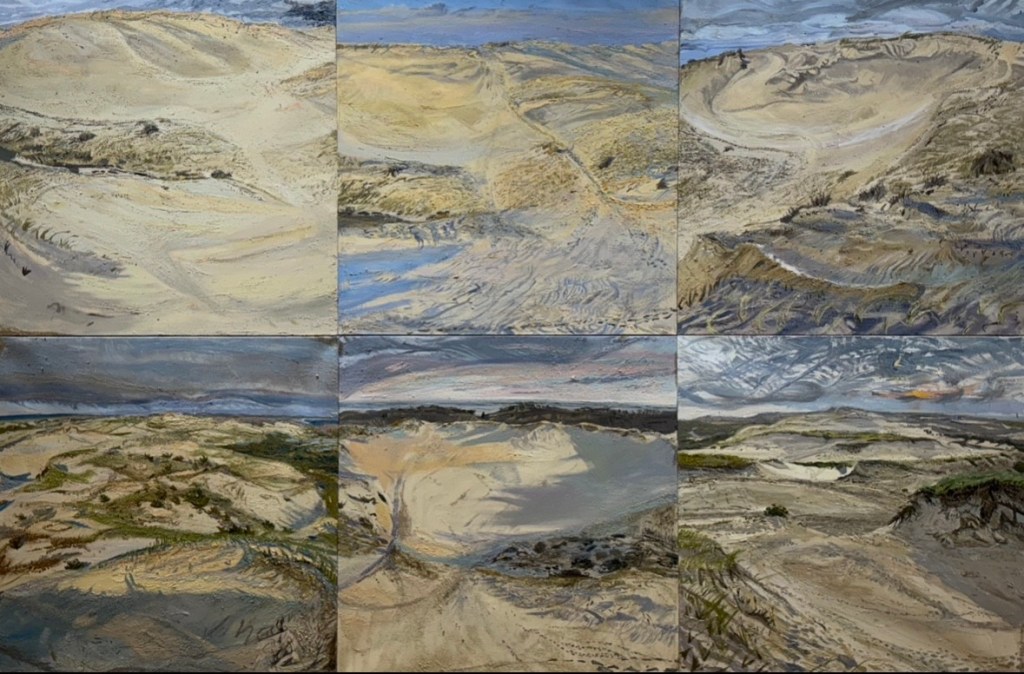
At first glance, Dunes resembles satellite views of Earth, echoing the constant vigilance implied in the show’s title. Usually a position high enough to offer lay of the land, “Lookout” also accentuates point of view, a value fundamental to the western landscape tradition. Shaped by linear perspective, empiricism, and psychology, individual viewpoint is asserted in careful measuring and the time-based tonality that Impressionism articulated, still found in contemporary realism like John Dubrow’s Israel pictures. Though Flood’s brushwork wields arcs, arabesques, and variegated facture, it culminates in illusionism – whose specificity and certainty are submerged in the forced chorus of the composite. Cross purpose begets equivocation, a nervous compulsion to see everything at once. Flood’s glimpses of the epic express the suppression of passion, a frustrated quest for the sublime implicating our overactive screen time and disembodied vision, even as it reaches past it.
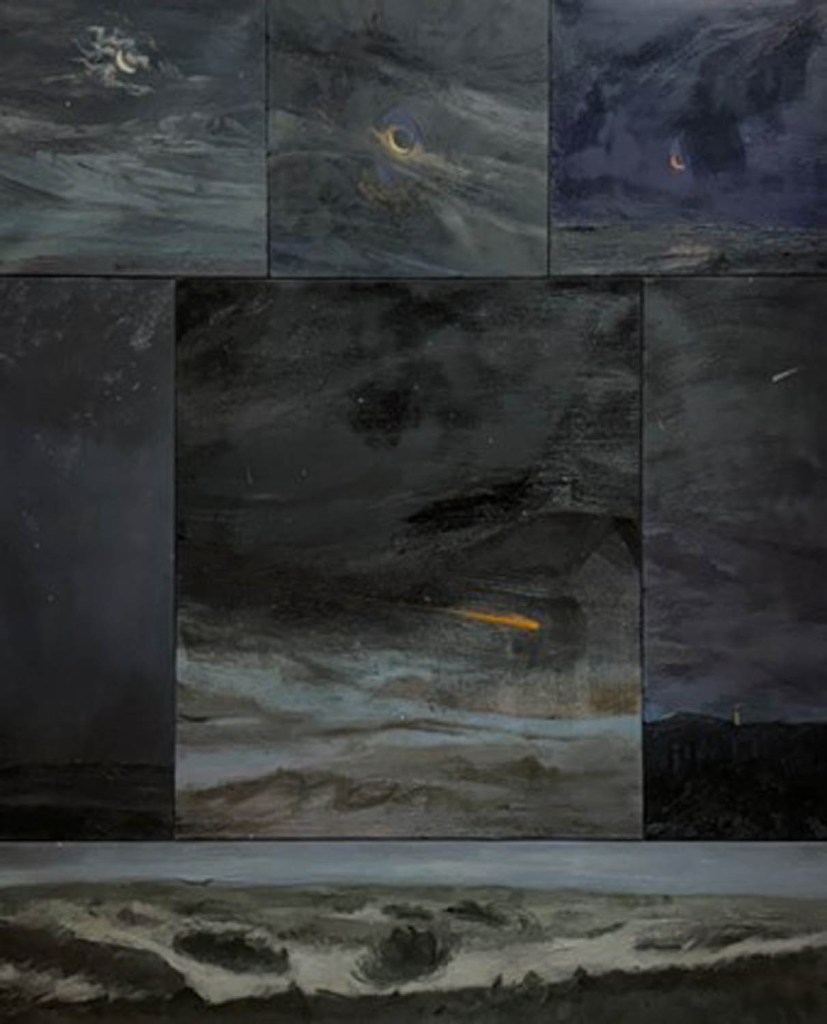
The horizon line, at singular eye level, underscores the painter’s position in landscape painting. It is again marginalized in the quiet montage Nightwatch (Dunes), as each panel captures a different night sky, attuned to nuances of waning sunlight and moon-glow on clouds. Placid surfaces, close values, and compositional simplicity evoke a wan, Whistler-like ethereality. Skillful tonality – as in the work of Diana Horowitz or Philip Geiger – working with the manipulation of edges fashioning space in the bottom panel, can only be mastered via observation. As Flood’s particulars draw us close, the distance the encompassing grid commands, from which angles remain perpendicular, stresses the impersonal. Unlike the more Dionysian Stanley Lewis, who extends his canvases as process demands, Flood’s stylish polyptychs only indirectly convey immediacy.

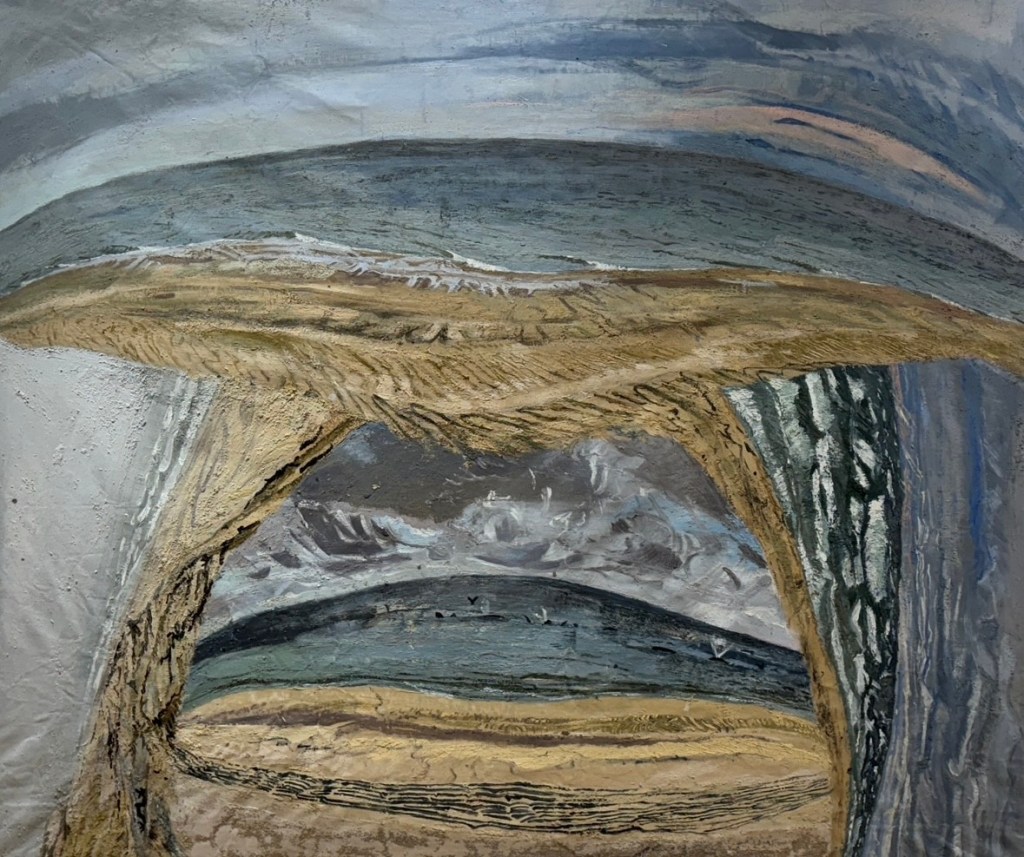
Everything is in flux, meanwhile, in the ink drawing Turbulence (Race Point), whose large size envelopes the viewer with AbEx exuberance. Loose, shaggy marks share some of Bonnard’s unrefined comity. The all-seeing image took turns as its maker’s orientation moved full circle around a lookout. Wind, waves, grass, and sand erode each other’s territory, as they increasingly contend in climate change. Yet the whole evokes a Walt Whitman-like excitation for life – the thrill of being in nature, seeing, creating.

Variations on a theme in landscape can occur when a particular motif offers technical exploration or inspiration, as in Cezanne’s investigation in Mont St. Victoire, or when a compositional matrix is discovered from a comfortable position; Monet apparently found both for his Rouen series. Iterations facilitate moving from one canvas to the next when a session achieves all it can, or when it’s ended by the impasse of changing light or weather. Unlike her polyptychs, Flood’s painting Turbulence (Race Point) combines, like the drawing, various viewpoints and experiences within one rectangle. Curves and rhythms intersect, recalling the struggle in Turner‘s sublime depiction of Hannibal crossing the Alps. But awesomeness is subverted as Flood’s closed forms accommodate each another, as in the lucid coordination of Max Beckmann’s landscapes. Haptic textures entertain and keep things at hand. Extreme bending resembles go-pro action videos to energize the image.
Mountains feature in Chinese ink landscapes and Japanese prints, and romantic paintings like those of Eduard Bierman, Casper Friedrich, Fransisco Goya, or Thomas Moran. Flood’s drawing Hudson River (Storm King Mountain) possesses both Western awe and foreboding, and the spiritual, monumental cast of Eastern views. But a gusto like that of Marsden Hartley flattens the mighty form, evoking play. While cropping puts us face to face with the huge rock, the mountain tops Flood’s assemblages. There, vision climbs through space, as it does in the vertical symbolic scheme from earth to heaven Renaissance painters like Titian employed.

Oil on linen | 54 x 60 inches
In the painting Hudson River (Storm King Mountain), the same peak presides over a beckoning foreground. The ordinary realm where boats pass spreads amply towards us in precise instances of current and reflection. Masters of water like Winslow Homer or Thomas Eakins both studied photography, which can now freeze moving water for close study. Homer owned a camera and Eakins used it for teaching, and studied Muybridge’s work. Whether or not Flood was assisted by photography, the cultural and technological change it has brought is activated. Today’s camera phones are not just tools, memory keepers and research archives, but extensions of human vision and venture. As much as Flood’s captivating polyptychs prize skillful observation and direct experience, they undermine it in disorienting fragmentation that subtly bemoans our dulled relationship to nature. “Lookout” is both a warning and invitation to cyber dwellers, as it transports the urban flaneur’s kaleidoscopic consciousness into the landscape.

“Elizabeth Flood: Lookout,” Storage, 52 Walker Street, 4th Floor, New York, NY. April 19–June 15, 2024.
About the author: Painter and art writer Margaret McCann teaches at the Art Students League. She has shown her work at Antonia Jannone in Milan and been reviewed in La Repubblica, Corriere della Sera, and the Huffington Post. She edited The Figure (Skira/Rizzoli 2014) for the New York Academy of Art and has written reviews for Painters’ Table and Art New England as well as Two Coats of Paint.



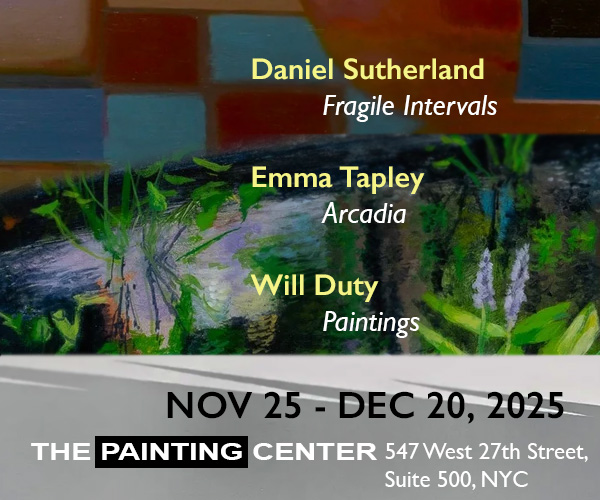
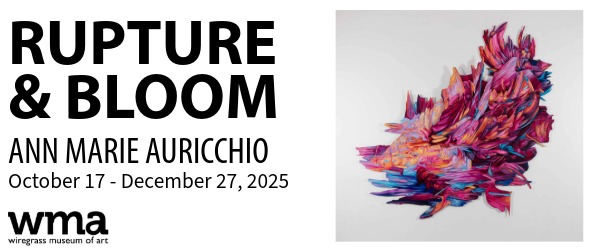














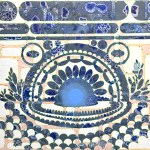



These are the most interesting landscapes I’ve seen in a while. Thanks.